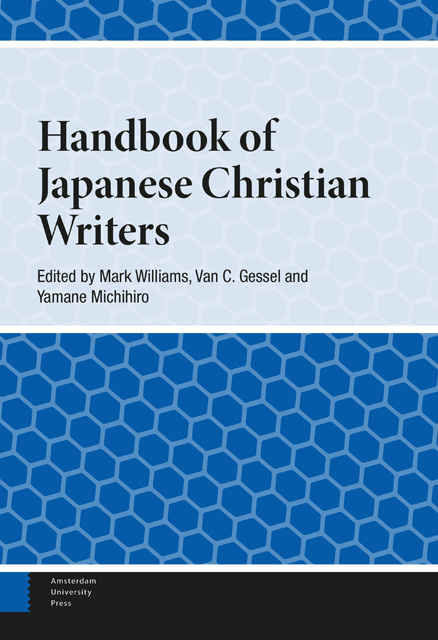Book contents
- Frontmatter
- Contents
- Contributors
- Abbreviations
- Preface
- Introduction
- 1 Prophet of the Inner Life: Kitamura Tōkoku
- 2 Shimazaki Tōson and Christianity: When the Cherries Ripen in the Taishō Period
- 3 Arishima Takeo and Christianity
- 4 Akutagawa Ryūnosuke: A Christian Life
- 5 Incarnation of the Christian Faith in the Poetry of Yagi Jūkichi
- 6 Hori Tatsuo: The Cross Dyed in Bloody Red and the Little Gods of Ancient Times
- 7 Nagai Takashi on Divine Providence and Christian Self-Surrender: Towards a New Understanding of hansai
- 8 Dazai Osamu: His Wrestle with the Bible
- 9 Shiina Rinzō: His Two Visages
- 10 From out of the Depths: Shimao Toshio’s Literary Response to Adversity
- 11 Yasuoka Shōtarō and Christianity: From Postwar “Emptiness” to Religious Longing
- 12 Miura Ayako and the Human Face of Faith
- 13 Endō Shūsaku and the Compassionate Companionship of Christ
- 14 Ogawa Kunio: Renewal of Faith and Identity in His seishomono (Bible Stories)
- 15 Kaga Otohiko: In Search of What Lies Beyond Death
- 16 Sono Ayako: Amor Vincit Omnia
- 17 Takahashi Takako: Drawing Closer to God Through Literature
- Index
- Index of titles
12 - Miura Ayako and the Human Face of Faith
Published online by Cambridge University Press: 09 June 2023
- Frontmatter
- Contents
- Contributors
- Abbreviations
- Preface
- Introduction
- 1 Prophet of the Inner Life: Kitamura Tōkoku
- 2 Shimazaki Tōson and Christianity: When the Cherries Ripen in the Taishō Period
- 3 Arishima Takeo and Christianity
- 4 Akutagawa Ryūnosuke: A Christian Life
- 5 Incarnation of the Christian Faith in the Poetry of Yagi Jūkichi
- 6 Hori Tatsuo: The Cross Dyed in Bloody Red and the Little Gods of Ancient Times
- 7 Nagai Takashi on Divine Providence and Christian Self-Surrender: Towards a New Understanding of hansai
- 8 Dazai Osamu: His Wrestle with the Bible
- 9 Shiina Rinzō: His Two Visages
- 10 From out of the Depths: Shimao Toshio’s Literary Response to Adversity
- 11 Yasuoka Shōtarō and Christianity: From Postwar “Emptiness” to Religious Longing
- 12 Miura Ayako and the Human Face of Faith
- 13 Endō Shūsaku and the Compassionate Companionship of Christ
- 14 Ogawa Kunio: Renewal of Faith and Identity in His seishomono (Bible Stories)
- 15 Kaga Otohiko: In Search of What Lies Beyond Death
- 16 Sono Ayako: Amor Vincit Omnia
- 17 Takahashi Takako: Drawing Closer to God Through Literature
- Index
- Index of titles
Summary
From the beginning of her career Miura Ayako, one of the most widely-read and popular Christian writers in Japan, was far from a “hidden” Christian. Openly declaring that her work as a writer was motivated by a desire to share the Gospel, her early novels Freezing Point and Shiokari Pass, and the autobiographical work, There is a Way, won for her a wide readership and sparked discussion in Japan on Christianity, the ideas of sin, faith, and redemption and the role of the Christian writer. A prolific writer throughout her career, Miura wrote in a variety of genres, including numerous essays, which directly address her own understanding of faith, and her final novel, Muzzle, is a saga that spans the entire Shōwa era and depicts one man's coming to faith after experiencing imprisonment and war. In all her works we see how Miura, and her characters, struggle with their own human weaknesses as they confront the meaning of belief, and its implications for their lives.
Introduction
Miura Ayako (1922–1999) made her literary debut in 1964, when her first novel Hyōten (Freezing Point*) was awarded first prize in a nationwide contest sponsored by the Asahi newspaper company. Winning out over 730 other entries, Miura, an unknown housewife in the Hokkaido city of Asahikawa, vaulted overnight from obscurity to literary stardom. Freezing Point marked the beginning of a long and successful career as a prolific and highly popular writer of novels, essays and biographies, with numerous TV and film adaptions of her better-known works, and over forty million in total sales (Kamide 2001, 117). Miura's success during the course of her career has sparked much debate over the relationship between “serious” and popular literature, and about the sometimes-intertwined role of religious faith and literature.
Unlike many other Christian writers in Japan, Miura Ayako has made it clear that her priority in writing was religious, rather than literary (Kamide 2001, 115–16). This arguably puts her in clear opposition to other Japanese Christian writers, such as Endō Shūsaku and Shimao Toshio, who see themselves more as writers first, and Christians second. As Miura puts it:
In my case, this might be a literature of apologetics, a proselytizing literature. In terms of literature, maybe that's not proper. But I have continued to write down to the present fully aware of these things.
- Type
- Chapter
- Information
- Handbook of Japanese Christian Writers , pp. 207 - 231Publisher: Amsterdam University PressPrint publication year: 2022

